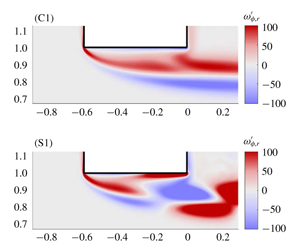Crossref Citations
This article has been cited by the following publications. This list is generated based on data provided by
Crossref.
Sabino, D.
Fabre, D.
Leontini, J. S.
and
Jacono, D. Lo
2020.
Vortex-induced vibration prediction via an impedance criterion.
Journal of Fluid Mechanics,
Vol. 890,
Issue. ,
Sierra, J.
Fabre, D.
Citro, V.
and
Giannetti, F.
2020.
Bifurcation scenario in the two-dimensional laminar flow past a rotating cylinder.
Journal of Fluid Mechanics,
Vol. 905,
Issue. ,
Pedergnana, Tiemo
Bourquard, Claire
Faure-Beaulieu, Abel
and
Noiray, Nicolas
2021.
Modeling the nonlinear aeroacoustic response of a harmonically forced side branch aperture under turbulent grazing flow.
Physical Review Fluids,
Vol. 6,
Issue. 2,
Son, Min
Armbruster, Wolfgang
Tonti, Federica
and
Hardi, Justin
2021.
Numerical study of acoustic resonance in a LOX injector post induced by orifice flow.
Sierra-Ausin, J.
Fabre, D.
Citro, V.
and
Giannetti, F.
2022.
Acoustic instability prediction of the flow through a circular aperture in a thick plate via an impedance criterion.
Journal of Fluid Mechanics,
Vol. 943,
Issue. ,
Kottapalli, Shravan
Hirschberg, A.
Waterson, Nicholas
Smeulders, David M.J.
and
Nakiboglu, Gunes
2022.
Influence of chamfers on broadband orifice noise in a water-pipe flow.
Nagy, Attila Balázs
Delfs, Jan
and
Bennett, Gareth J.
2022.
Aeroacoustics research in Europe: The CEAS-ASC report on 2020 & 2021 highlights.
Journal of Sound and Vibration,
Vol. 534,
Issue. ,
p.
117002.
Hirschberg, Lionel
Guzman Inigo, Juan G.
Aulitto, Alessia
Sierra, Javier
Fabre, David
Morgans, Aimee
and
Hirschberg, A.
2022.
Linear Theory and Experiments for Laminar Bias Flow Impedance: Orifice Shape Effect.
Kottapalli, Shravan
Hirschberg, Avraham
Anantharaman, Vinod
Smeulders, David M.J.
Waterson, Nicholas
and
Nakiboglu, Gunes
2022.
Hydrodynamic and acoustic pressure fluctuations in water pipes due to an orifice: Comparison of measurements with Large Eddy Simulations.
Journal of Sound and Vibration,
Vol. 529,
Issue. ,
p.
116882.
Heckl, Maria A.
Gopinathan, Sreenath Malamal
and
Surendran, Aswathy
2022.
A unified framework for acoustic instabilities based on the tailored Green’s function.
Journal of Sound and Vibration,
Vol. 541,
Issue. ,
p.
117279.
Mohamed, Hammam
Sesterhenn, Jörn
and
Biancofiore, Luca
2023.
The effect of side walls on the stability of falling films.
Journal of Fluid Mechanics,
Vol. 964,
Issue. ,
Magri, Luca
Schmid, Peter J.
and
Moeck, Jonas P.
2023.
Linear Flow Analysis Inspired by Mathematical Methods from Quantum Mechanics.
Annual Review of Fluid Mechanics,
Vol. 55,
Issue. 1,
p.
541.
Aulitto, Alessia
Hirschberg, Avraham
Lopez Arteaga, Ines
and
Saxena, Vertika
2023.
Experimental study of a slit in the presence of a bias flow under medium- and high-level acoustic excitations.
International Journal of Spray and Combustion Dynamics,
Vol. 15,
Issue. 2,
p.
117.
Kottapalli, Shravan
van Aken, Stijn
Hirschberg, Avraham
Waterson, Nicholas
Smeulders, David
and
Nakiboglu, Gunes
2023.
Influence of orifice thickness and chamfer on broadband noise in a water circuit.
Acta Acustica,
Vol. 7,
Issue. ,
p.
66.
Guzmán-Iñigo, Juan
and
Morgans, Aimee S.
2024.
Designing the edges of holes (with bias flow) to maximise acoustic damping.
Journal of Sound and Vibration,
Vol. 575,
Issue. ,
p.
118224.
Muthaiah, M
Saini, Suraj
and
Varunkumar, S
2025.
Whistling potential of throttling orifices and its connection to liquid rocket combustion instability.
Applied Acoustics,
Vol. 229,
Issue. ,
p.
110361.
Morgans, Aimee S.
and
Yang, Dong
2025.
Thermoacoustic Instability in Combustors.
Annual Review of Fluid Mechanics
,
Vol. 57,
Issue. 1,
p.
9.
HU, Jiahao
XU, Ruize
XU, Dengke
DONG, Xu
LI, Jia
SUN, Dakun
and
SUN, Xiaofeng
2025.
An input-output analysis on flow stability of transonic compressors with impedance boundary condition.
Chinese Journal of Aeronautics,
Vol. 38,
Issue. 3,
p.
103349.
